Putting a rug in the right spot under your sectional sofa can make a big difference in how your room looks and feels. When done right, a well-placed rug ties all your furniture together and creates a complete space.
Getting it wrong can make even the nicest room feel off-balance or awkward.
In this guide, you’ll learn the basic rules for rug placement with sectional sofas.
We’ll cover how to pick the proper rug placement with the living room sectional, where to put the rug, and common mistakes to avoid. You’ll also find useful tips for different room layouts and sofa shapes.
By the end, you’ll know exactly how to place a rug that makes your living room look put together and feel just right.
Size Considerations for Rugs with Sectionals
- For most sectional arrangements, 8×10 or 9×12 rugs work best. Larger rooms may need 10×14 rugs, while small sectionals can use 6×9 rugs.
- To measure your space correctly, measure your sectional’s full footprint, then add 18-24 inches on each open side to find your ideal rug size.
- The “front legs on the rug” rule means positioning your rug so that at least the front legs of your sectional rest on it, creating a unified seating area.
- For good size ratios, your rug should extend 18-30 inches beyond your sectional on open sides and be at least as wide as your sectional’s longest part.
Avoid rugs that stop at the edge of your sectional (too small) or nearly touch the walls (too large). Leave 8-12 inches of floor showing between your rug and walls.
Rug Placement Options for Sectional Sofas
Proper rug placement helps tie your sectional and furniture together, making your space feel cohesive and visually pleasing.
1. All Legs on the Rug (Oversized Area Rug)
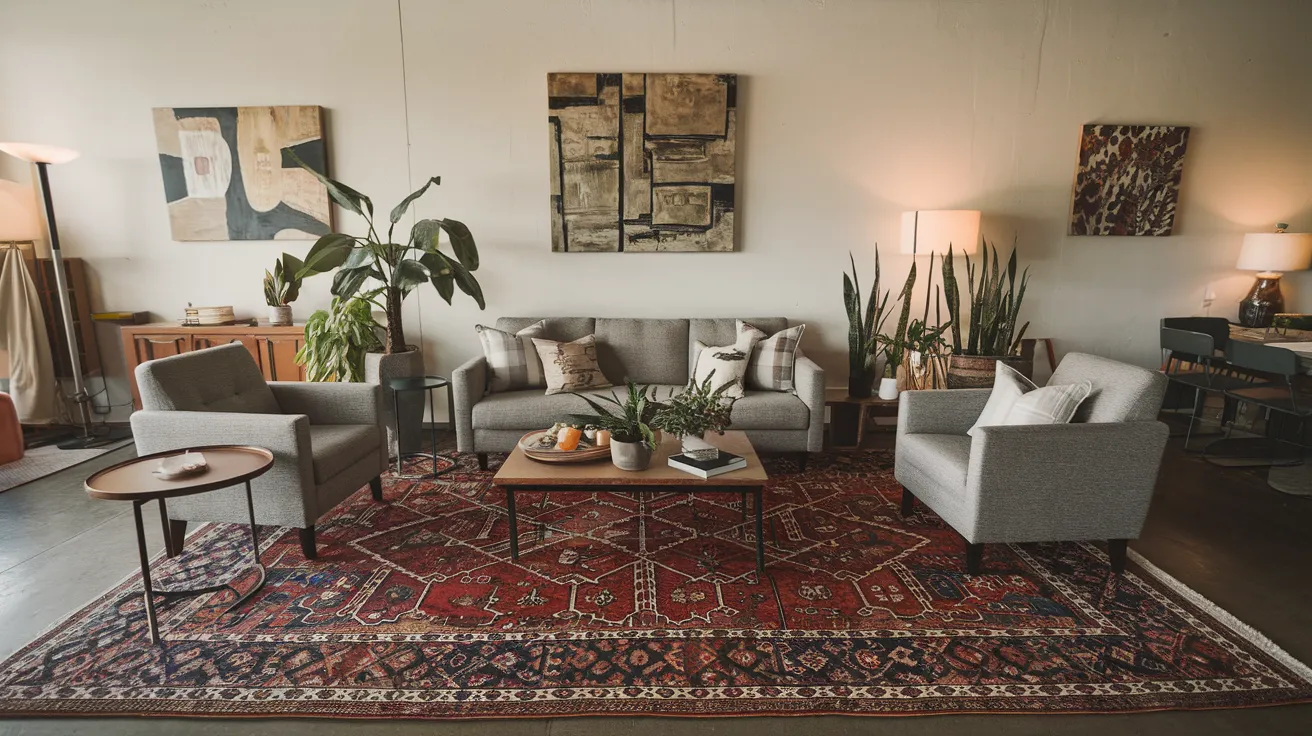
- Benefits of this approach: It creates a unified look that makes the room feel larger and more cohesive. This placement clearly defines your seating area and adds comfort since the entire seating is on a soft surface.
- Room size requirements: Works best in large rooms where you can use rugs 9×12 or larger. Your room should have at least 12-18 inches of floor space visible around the rug’s edges.
- What furniture should be included: All seating pieces plus the coffee table should fit completely on the rug. Side tables can be half on or half off.
2. Front Legs Only Placement
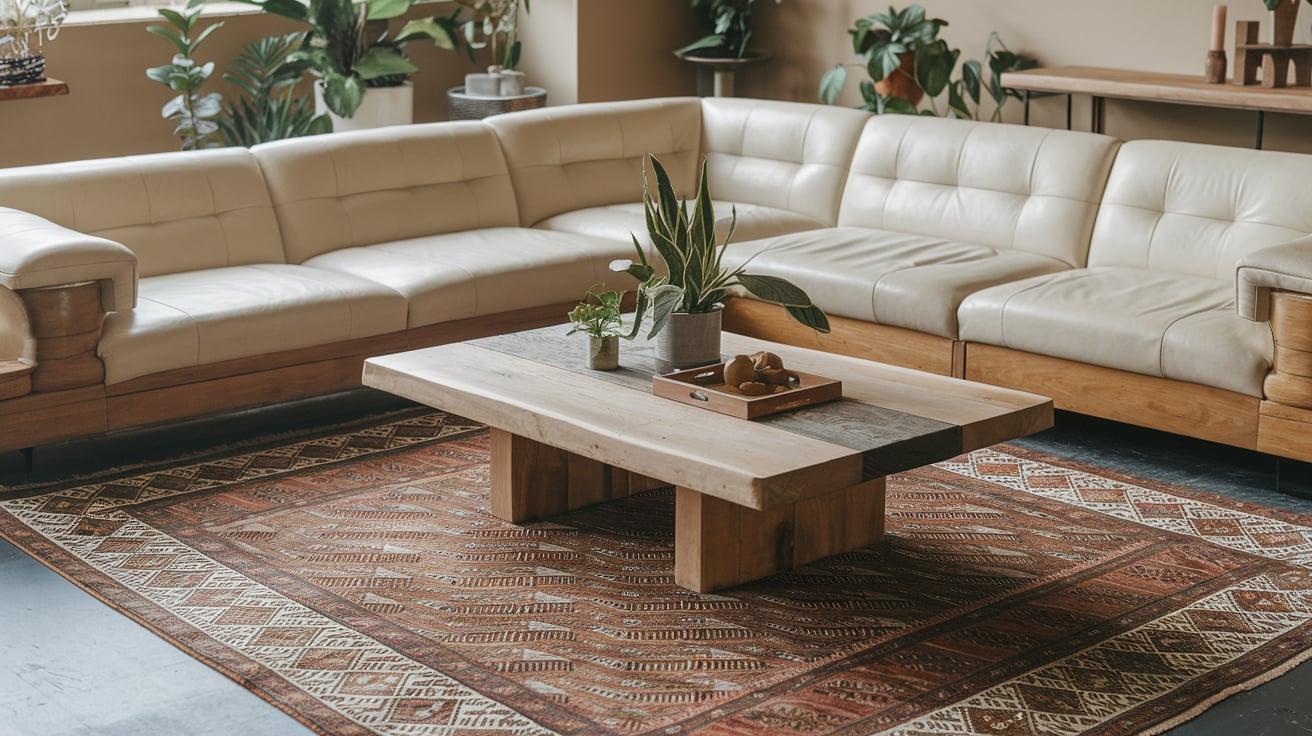
- How to position for optimal effect: Place the rug so just the front legs of your sectional rest on it, keeping the back legs on the floor. The rug should extend at least 12-18 inches beyond the front edge of the sectional.
- Benefits of this classic approach: Costs less than oversized rugs while connecting all seating pieces. It creates a clear seating zone and works well in medium-sized rooms.
- Coffee table positioning with this style: The coffee table should sit completely on the rug, centered within the seating area.
3. Matching Corners Alignment
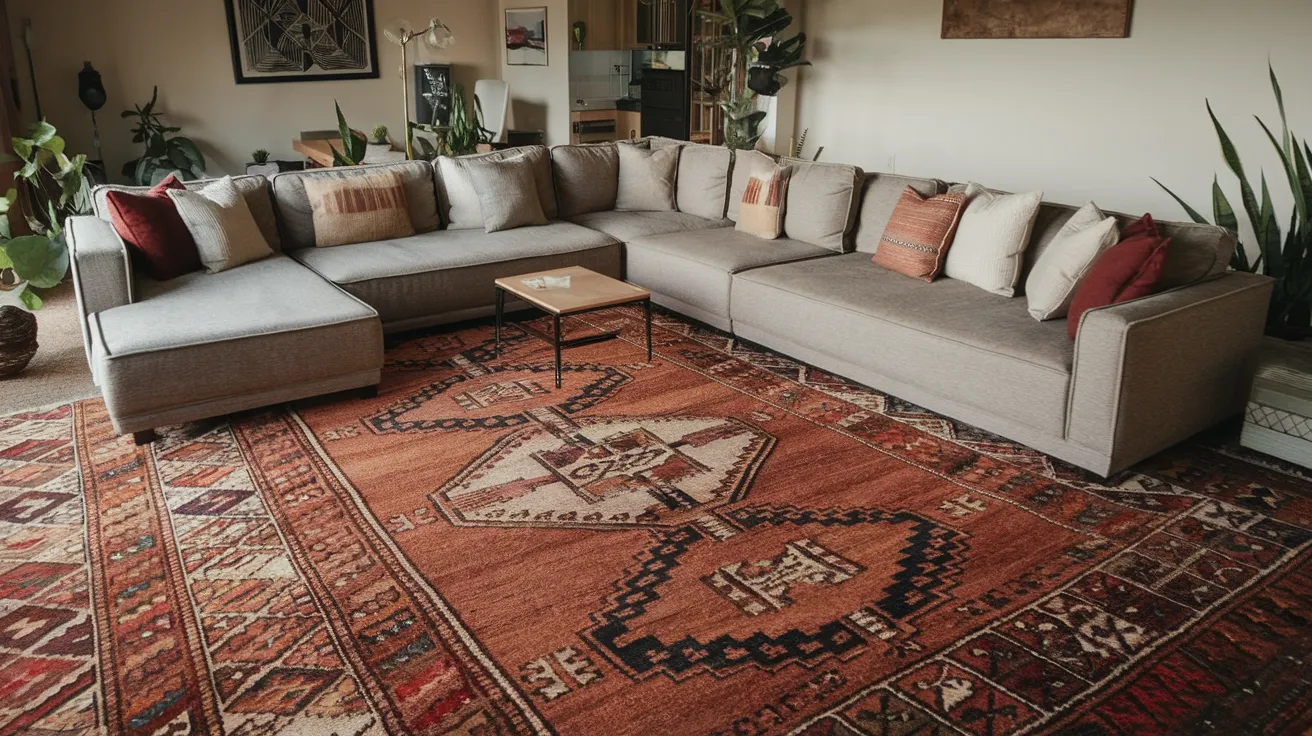
- How to align corners for visual balance: Line up one corner of your rug with the main corner of your L-shaped sectional. This creates a strong visual line and makes the arrangement look planned.
- Managing excess rug space: The extra rug area should extend toward the open side of the room, creating a balanced look. Use this extra space for a coffee table or accent chairs.
4. Centered Room Placement
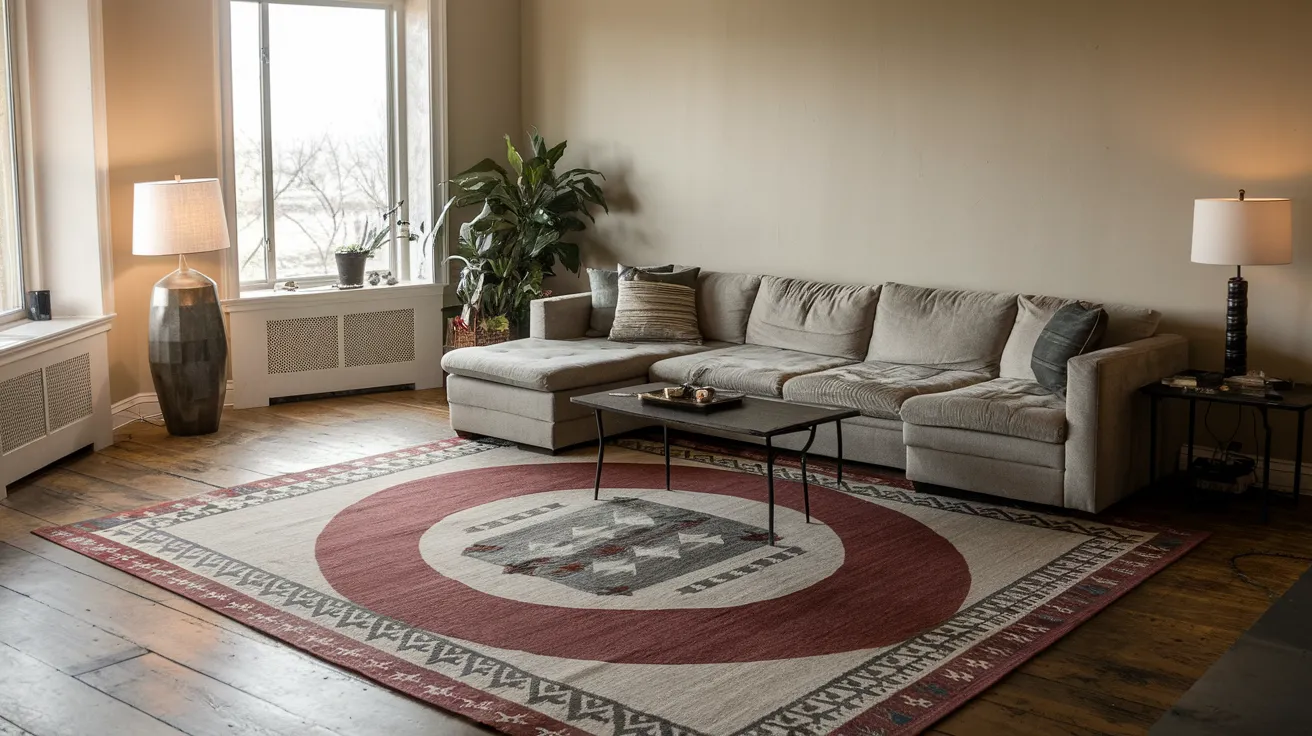
- Positioning rug first, sectional second: Start by placing the rug in the center of the room, then arrange your sectional and other furniture around it.
- Creating a focal point: This method works well when your rug has a strong pattern or design in the center you want to highlight.
- Balance considerations: Ensure the rug extends equally beyond the sectional on all open sides to maintain visual balance.
5. Aligned with the Longest Section

- Techniques for visual symmetry: Place the rug parallel to the longest part of your sectional, with equal amounts of rug showing on each end.
- Handling the shorter sides of the sectional: The shorter side can have less rug extension, but aim for at least 6-8 inches beyond the sectional edge.
6. Special Considerations for L-Shaped Sectionals

- Extending under the chaise: Ensure the rug extends fully under the chaise section for a balanced look. This gives proper support to this often-used section.
- Creating balance with asymmetrical furniture: Use the rug to create a rectangular shape that balances out the L-shape of the sectional.
7. U-Shaped Sectional Placement Strategies
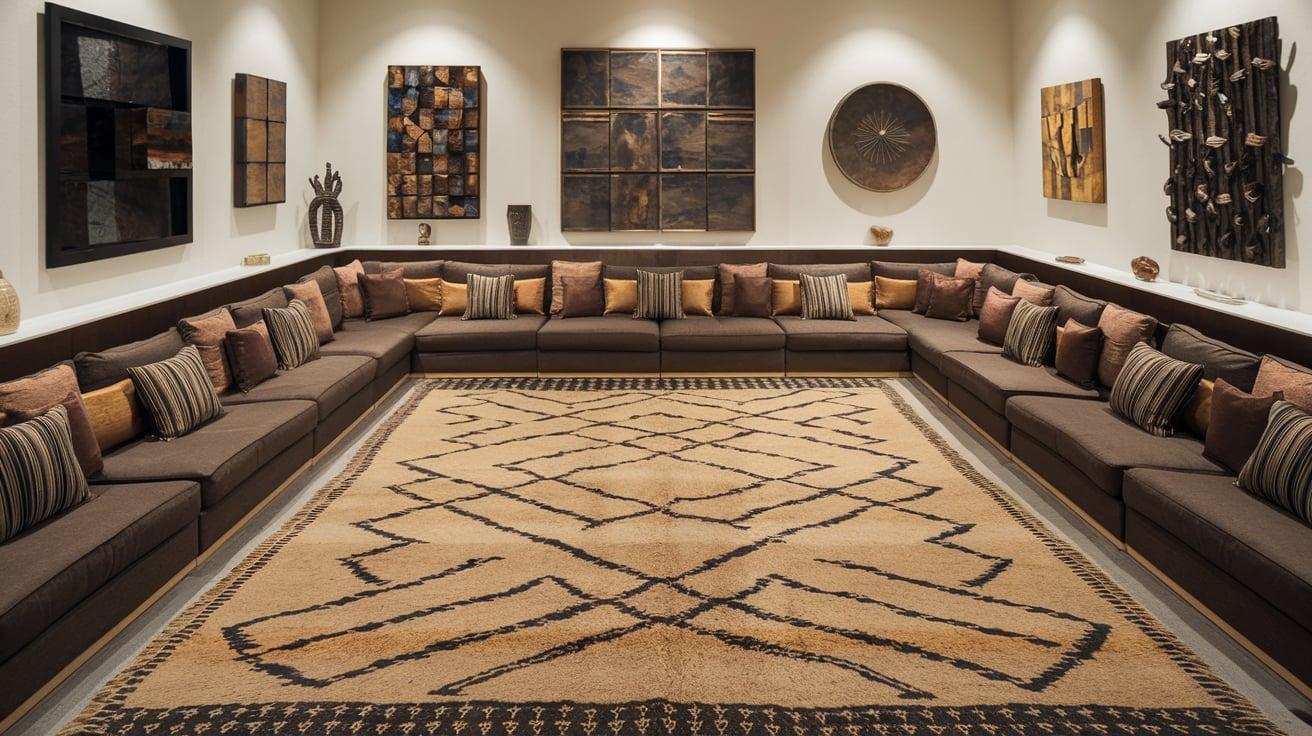
- Centering techniques: Place the rug in the U’s center, ensuring it fills most of the inner space.
- Size requirements: U-shaped sectionals need large rugs (10×14 or bigger) to work well. The rug should extend at least 12 inches beyond all open sides of the sectional.
8. Round Rug Options
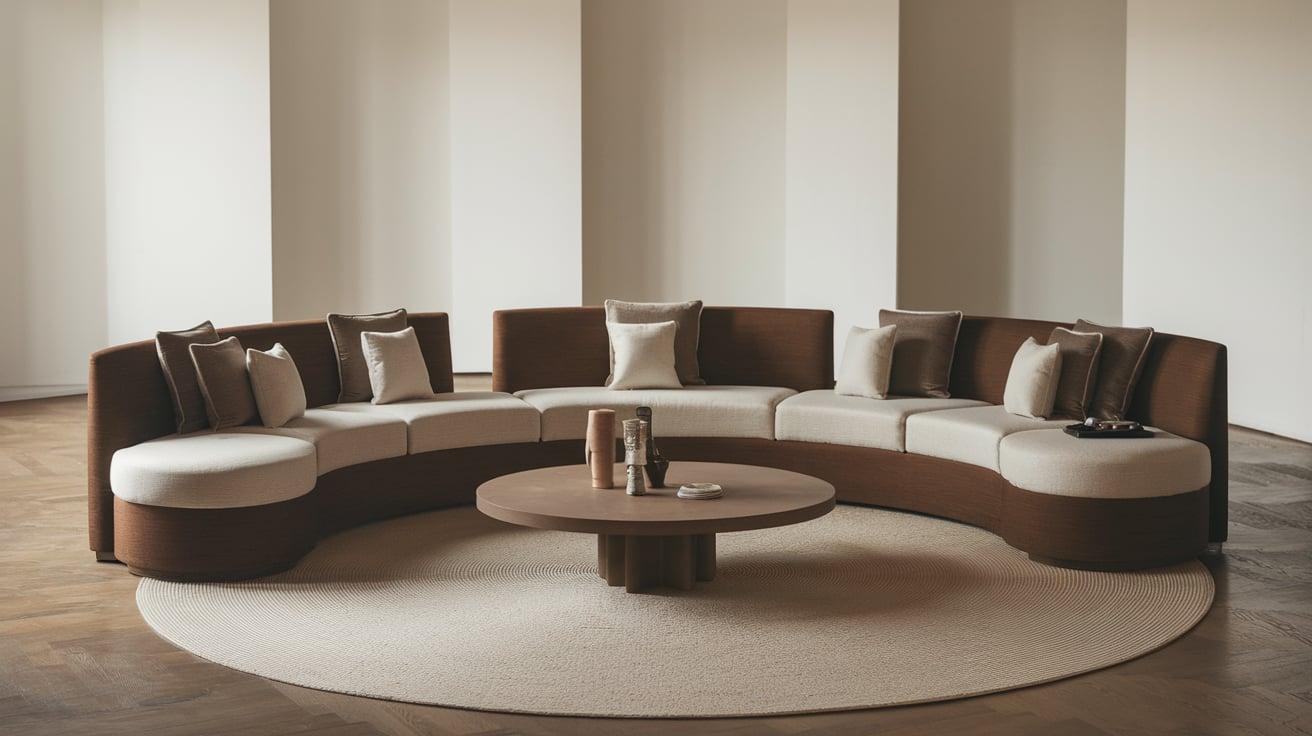
- When to choose circular rugs: Round rugs work well with curved sectionals or when you want to soften the sharp angles of an L-shaped sectional.
- Coffee table coordination: Pair a round rug with a round coffee table for a cohesive look.
- Best sectional configurations for round rugs: Curved sectionals, small L-shapes, or sectionals with rounded edges match well with round rugs.
9. Asymmetrical Placement
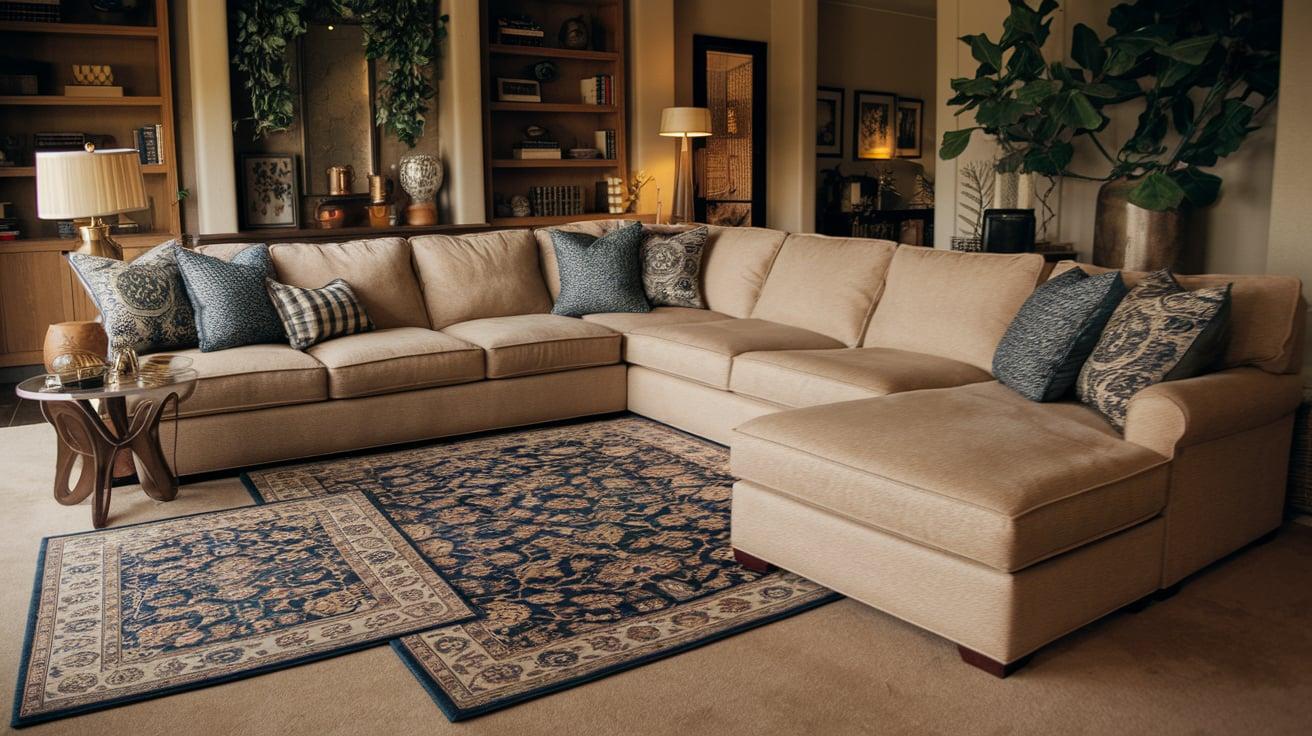
- Creating visual interest: Place the rug off-center to the sectional to create a more casual, less formal look.
- Benefits for smaller spaces: This approach can make small rooms feel larger by creating the feeling of extra floor space.
- Making smaller rugs work: If your rug is smaller than ideal, asymmetrical placement can still make it work by focusing on key areas.
10. Diagonal Placement
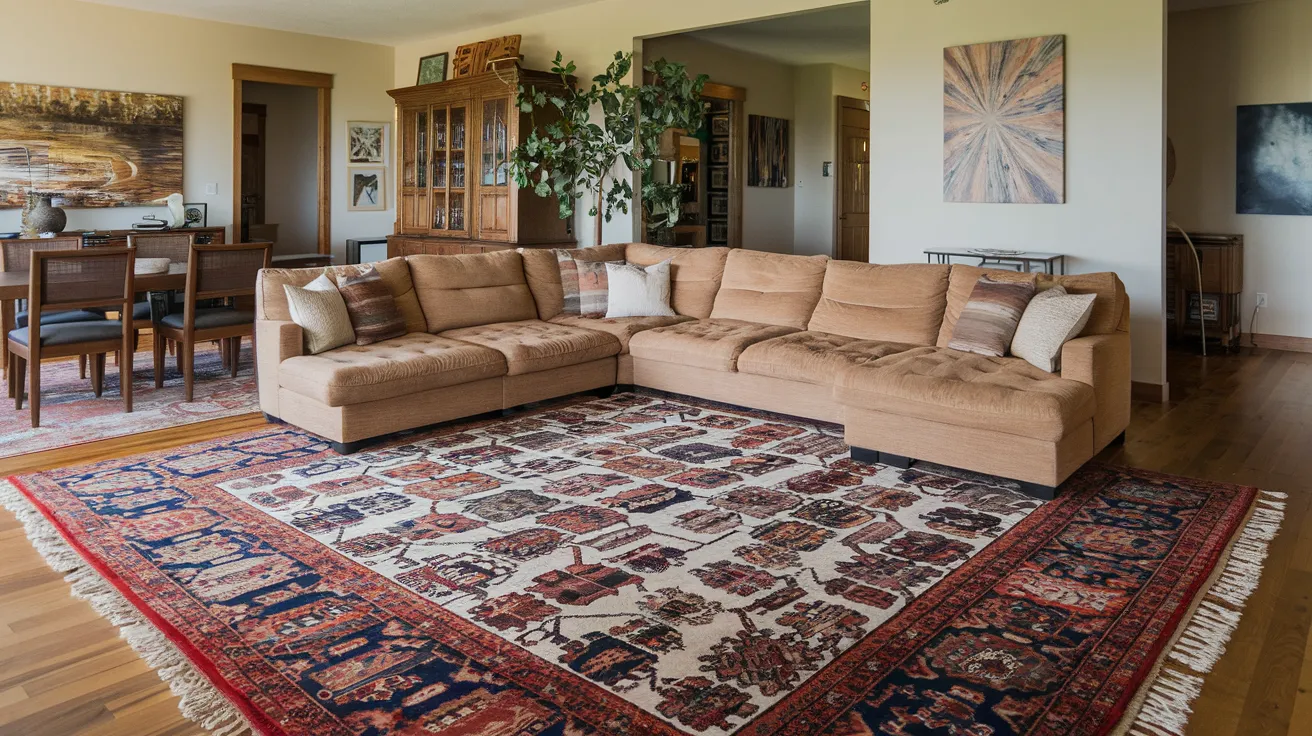
- Creating flow between rooms: Placing a rug at a diagonal angle can help guide traffic flow and connect different areas in open floor plans.
- When this works best: This works well in large, open spaces or when your sectional is placed at an angle rather than parallel to walls.
- Visual considerations: The diagonal placement creates dynamic lines that make a room feel more active and less static.
Practical Considerations
Leave 18-24 inches of walking space around your sectional and furniture to create clear pathways.
To protect your floor, position the rug to cover main walking paths in high-traffic areas. Choose rugs with low piles and dark patterns to hide dirt.
Always use rug pads to prevent shifting and protect your floor. Consider all furniture in the room; side tables and bookshelves should be fully on or off the rug.
Make sure the carpet doesn’t block doors from opening freely.
Style and Pattern Selection
For color coordination, pick rug colors that connect with your sectional. If your sectional is solid, choose a rug with that color as an accent.
For patterned sectionals, pull out one of the less noticeable colors for your rug. Aim for contrast—light rugs with dark sectionals or dark rugs with light sectionals create visual interest.
Small rooms work better with smaller patterns or solid colors. Make sure the pattern size feels right for your space—too small can look fussy, and too large can feel overwhelming.
Match the rug texture to your sectional fabric. Smooth leather or microfiber sectionals pair well with plush, soft rugs that add warmth. For textured fabric sectionals, consider flatter weave rugs to avoid competing textures. The carpet should offer a nice contrast to how your sectional feels.
Neutral rugs (beige, gray, cream) work in most settings and make furniture the focus. They’re also easier to keep when you change other decor. Statement rugs with bold colors or patterns become the room’s main feature and set the tone for everything else.
Consider how the rug will look from different angles, especially with L-shaped sectionals where people view the room from various positions.
Solutions for Common Problems
When your sectional is too large for standard rugs, consider using two matching rugs side by side or custom-cutting a larger rug to fit your space.
For awkward room layouts, focus on creating balance rather than following strict rules; sometimes, placing the rug at a slight angle works better than perfect alignment.
If your existing carpet is too small, use it under the coffee table as a focal point, or ensure it extends partly under the sectional.
Layering rugs offers a versatile solution—start with a large, plain base rug covering most of the seating area, then add a smaller, more colorful rug on top.
This approach creates the right size while adding style and texture, protecting carpeting, or adjusting positions seasonally.
Conclusion
Always measure your space and sectional before buying a rug to avoid costly mistakes.
The right rug should extend 18-24 inches beyond your sectional on open sides, with at least the front legs on the carpet.
Choose colors that complement your sectional and match the rug texture to contrast with your sofa fabric for the most cohesive look.
Proper placement defines your seating area and ties the room together. Don’t forget a quality rug pad to prevent slipping.
Whether you choose a neutral base or bold statement piece, the perfect rug will make your sectional arrangement feel complete and well-designed.














